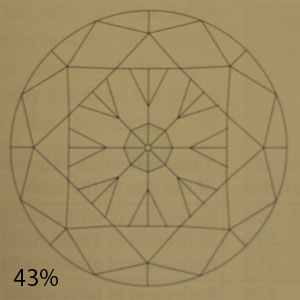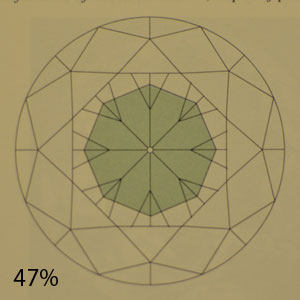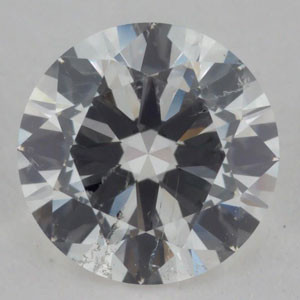The table facet of a diamond works together with the pavilion facets to drive the light performance of a diamond. The table facet is the largest ‘window’ into the diamond allowing light in and the pavilion facets act as ‘mirrors’ to return that light to the observer. The relationship between the two facets also has a huge impact on the appearance of the diamond.
Large Table Facets (59-61%)
A large table facet allows more light into the diamond and therefore a diamond with a large table will tend to be brighter. A diamond with a larger table will also have more spread. This is because for the same carat weight, a larger table facet means having a lower crown.
Less weight going into the crown height means more weight can go into making the diamond bigger. Apart from having better spread, a large table can create the perception that a diamond is bigger than it really is. A bigger and brighter diamond might seem to be some pretty good advantages of having a large table facet, but there are also some trade-offs.
One trade-off is that a large table with a low crown results in a diamond having less fire. Another problem is that as the table gets bigger, the reflection of the table facet that can be seen in the center of the diamond also gets bigger. A large table reflection can be distracting and is considered undesirable as it takes away from the brightness of the diamond.
When you get to really large tables (>61%), if the pavilion is also on the steep side, then the reflection of the girdle can be seen through the table from the face up view. Diamonds with this problem are known as ‘fish-eyes’ because that’s exactly what they look like.
Small Table Facets (50% – 52%)
A diamond with a small table will tend to have a high crown that will give off more fire. However, there is a limit to this type of optimization because a diamond with an extremely high crown will take on an odd profile. The weight going into the crown means that small table diamonds are bad for spread.
If you tried to give a diamond with a small table a normal crown height, the crown angles will be too shallow and very shallow crowns are more susceptible to chipping, especially when they are paired with a very-thin to thin girdle.
Another thing that indicates a table facet is too small is when the diamond begins to look small for its weight. This can happen when a diamond does not have good edge-to-edge light return because light return is strongest under the table facet in most diamonds.
Ideal Table Size (53%-58%)
Within this range of ideal table sizes, light performance is not very sensitive to changes in the size of the table facet. What is more significant are the changes to the contrast pattern and the effects on spread.
In my opinion, the difference in brightness between a diamond with a 58% table and a 56% table is negligible. In the same way, the difference in fire between a diamond with a 53% table and a 55% table is negligible. A balanced table percentage is between 55 – 57%. My personal preference is a 57% table because this maximizes the spread of a diamond while still maintaining a balanced light performance and at the same time having a small table reflection.
Table Reflection
The table reflection is the small octagon at the center of the diamond and it’s size is affected by both the size of the table facet and the pavilion depth.
• A bigger table translates to a bigger table reflection as a percentage of the diameter.
• A deeper pavilion translates to a bigger table reflection as a percentage of the table.
I was given permission from Good Old Gold to reproduce this image of a comparison between a diamond with a 58% table and one with a 56% table with basically all the other proportions the same.
Both of these table sizes are actually within what is acceptable to me. I’m showing you this so you can determine whether a large table is acceptable to you. You can see that there is actually a significant difference in the size of the table reflection with just a 2% difference in table size.
Pavilion Depth
In a round brilliant diamond, the pavilion depth and pavilion angle are directly related to each other. On a GIA certificate, you will notice that a 40.6/40.8/41 degree pavilion angle translates to a 42.5/43/43.5% depth respectively. Interestingly, if you do the math, a 40.6 degree pavilion angle equals to a 42.8% pavilion depth, but GIA rounds this down to 42.5%.
The most important thing you need to know about the pavilion angle is that 41 degrees is generally accepted to be the furthest you can take a diamond before it begins to leak light. Although the effect isn’t a ‘cliff’ per say, there is still a rather sharp decline in light return starting at 41 degrees and this quickly leads to light leakage when paired with my recommended range of crown angles.
| Pavilion Depth % | Table Reflection as a % of Table Size |
| 42 | 20 |
| 43 | 30 |
| 44 | 40 |
| 45 | 50 |
| 46 | 60 |
| 47 | 70 |
| 48 | 80 |
| 49 | 90 |
| 50 | 100 |
The table above shows the relationship between the pavilion depth and the table reflection. From the table, you can quickly see why you are unlikely to come across a diamond with a pavilion depth larger than 44%.
Lets have a look at how varying the pavilion depth affects the table reflection visually.




It should be clear that anything above 44% quickly becomes unacceptable to most people.
Bear in mind that the two effects discussed above stack with each other so you should avoid combinations of steep pavilions and large tables. Now that you understand this, you should be able to see that it is possible to get away with a larger table size if you find a stone with a shallower pavilion.
Does this mean you want to find as shallow a pavilion as possible?
The problem with having a shallow pavilion in combination with a large table is that it leads to diamonds with fish-eyes. The shallower the pavilion, the smaller the table needs to be in order to produce a fish-eye. With very shallow pavilions, there will also be an issue with light obstruction. Obstruction occurs when a diamond reflects too much of observer or in the case of a photograph, the camera lens. You will begin to notice this increased obstruction in diamonds that have pavilion angle of 40.4 degrees or lower.
For example, the diamond below has a 40.4 degree pavilion angle.
(This image is courtesy of James Allen, used with permission.)
The result is that the diamond appears dark at normal viewing distances because the arrows of the diamond remain dark from arms length and seem clustered together, what is known as the ‘nail-head’ phenomena. The term comes from seeing the reflection of your head in the center of the diamond that looks just like the head of a nail. Please note that all diamonds will have varying degrees of obstruction problems when it is tilted.
Conclusion
To summarize, a diamond with too large a table and too shallow of a pavilion will potentially be a fish-eye. A diamond with too shallow of a pavilion will also have light obstruction problems and potentially display the nail-head phenomenon. A diamond with a table that is too small will be less bright and may look odd from a profile view.
A diamond with a pavilion that is too deep will have light leakage. A deep pavilion in combination with a large table will cause a large table reflection that may be distracting. A diamond with a large table and shallow crown angles will have better spread and can look big for its weight but it will also have less fire. I recommend table sizes between 55 – 57% and pavilion angles between 40.6 – 40.8 degrees (42.5-43% pavilion depth).

